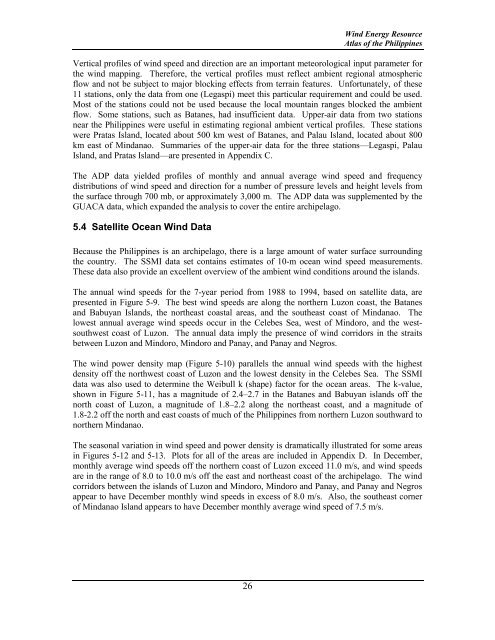Wind Energy Resource Atlas of the Philippines - NREL
Wind Energy Resource Atlas of the Philippines - NREL
Wind Energy Resource Atlas of the Philippines - NREL
You also want an ePaper? Increase the reach of your titles
YUMPU automatically turns print PDFs into web optimized ePapers that Google loves.
26<br />
<strong>Wind</strong> <strong>Energy</strong> <strong>Resource</strong><br />
<strong>Atlas</strong> <strong>of</strong> <strong>the</strong> <strong>Philippines</strong><br />
Vertical pr<strong>of</strong>iles <strong>of</strong> wind speed and direction are an important meteorological input parameter for<br />
<strong>the</strong> wind mapping. Therefore, <strong>the</strong> vertical pr<strong>of</strong>iles must reflect ambient regional atmospheric<br />
flow and not be subject to major blocking effects from terrain features. Unfortunately, <strong>of</strong> <strong>the</strong>se<br />
11 stations, only <strong>the</strong> data from one (Legaspi) meet this particular requirement and could be used.<br />
Most <strong>of</strong> <strong>the</strong> stations could not be used because <strong>the</strong> local mountain ranges blocked <strong>the</strong> ambient<br />
flow. Some stations, such as Batanes, had insufficient data. Upper-air data from two stations<br />
near <strong>the</strong> <strong>Philippines</strong> were useful in estimating regional ambient vertical pr<strong>of</strong>iles. These stations<br />
were Pratas Island, located about 500 km west <strong>of</strong> Batanes, and Palau Island, located about 800<br />
km east <strong>of</strong> Mindanao. Summaries <strong>of</strong> <strong>the</strong> upper-air data for <strong>the</strong> three stations—Legaspi, Palau<br />
Island, and Pratas Island—are presented in Appendix C.<br />
The ADP data yielded pr<strong>of</strong>iles <strong>of</strong> monthly and annual average wind speed and frequency<br />
distributions <strong>of</strong> wind speed and direction for a number <strong>of</strong> pressure levels and height levels from<br />
<strong>the</strong> surface through 700 mb, or approximately 3,000 m. The ADP data was supplemented by <strong>the</strong><br />
GUACA data, which expanded <strong>the</strong> analysis to cover <strong>the</strong> entire archipelago.<br />
5.4 Satellite Ocean <strong>Wind</strong> Data<br />
Because <strong>the</strong> <strong>Philippines</strong> is an archipelago, <strong>the</strong>re is a large amount <strong>of</strong> water surface surrounding<br />
<strong>the</strong> country. The SSMI data set contains estimates <strong>of</strong> 10-m ocean wind speed measurements.<br />
These data also provide an excellent overview <strong>of</strong> <strong>the</strong> ambient wind conditions around <strong>the</strong> islands.<br />
The annual wind speeds for <strong>the</strong> 7-year period from 1988 to 1994, based on satellite data, are<br />
presented in Figure 5-9. The best wind speeds are along <strong>the</strong> nor<strong>the</strong>rn Luzon coast, <strong>the</strong> Batanes<br />
and Babuyan Islands, <strong>the</strong> nor<strong>the</strong>ast coastal areas, and <strong>the</strong> sou<strong>the</strong>ast coast <strong>of</strong> Mindanao. The<br />
lowest annual average wind speeds occur in <strong>the</strong> Celebes Sea, west <strong>of</strong> Mindoro, and <strong>the</strong> westsouthwest<br />
coast <strong>of</strong> Luzon. The annual data imply <strong>the</strong> presence <strong>of</strong> wind corridors in <strong>the</strong> straits<br />
between Luzon and Mindoro, Mindoro and Panay, and Panay and Negros.<br />
The wind power density map (Figure 5-10) parallels <strong>the</strong> annual wind speeds with <strong>the</strong> highest<br />
density <strong>of</strong>f <strong>the</strong> northwest coast <strong>of</strong> Luzon and <strong>the</strong> lowest density in <strong>the</strong> Celebes Sea. The SSMI<br />
data was also used to determine <strong>the</strong> Weibull k (shape) factor for <strong>the</strong> ocean areas. The k-value,<br />
shown in Figure 5-11, has a magnitude <strong>of</strong> 2.4–2.7 in <strong>the</strong> Batanes and Babuyan islands <strong>of</strong>f <strong>the</strong><br />
north coast <strong>of</strong> Luzon, a magnitude <strong>of</strong> 1.8–2.2 along <strong>the</strong> nor<strong>the</strong>ast coast, and a magnitude <strong>of</strong><br />
1.8-2.2 <strong>of</strong>f <strong>the</strong> north and east coasts <strong>of</strong> much <strong>of</strong> <strong>the</strong> <strong>Philippines</strong> from nor<strong>the</strong>rn Luzon southward to<br />
nor<strong>the</strong>rn Mindanao.<br />
The seasonal variation in wind speed and power density is dramatically illustrated for some areas<br />
in Figures 5-12 and 5-13. Plots for all <strong>of</strong> <strong>the</strong> areas are included in Appendix D. In December,<br />
monthly average wind speeds <strong>of</strong>f <strong>the</strong> nor<strong>the</strong>rn coast <strong>of</strong> Luzon exceed 11.0 m/s, and wind speeds<br />
are in <strong>the</strong> range <strong>of</strong> 8.0 to 10.0 m/s <strong>of</strong>f <strong>the</strong> east and nor<strong>the</strong>ast coast <strong>of</strong> <strong>the</strong> archipelago. The wind<br />
corridors between <strong>the</strong> islands <strong>of</strong> Luzon and Mindoro, Mindoro and Panay, and Panay and Negros<br />
appear to have December monthly wind speeds in excess <strong>of</strong> 8.0 m/s. Also, <strong>the</strong> sou<strong>the</strong>ast corner<br />
<strong>of</strong> Mindanao Island appears to have December monthly average wind speed <strong>of</strong> 7.5 m/s.
















